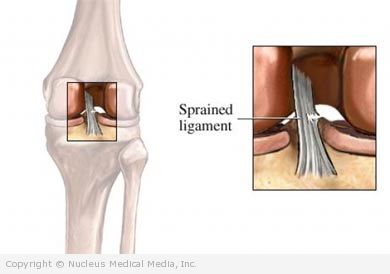Sprain – Definition
A sprain is an injury that damages a ligament. A ligament is a firm, fibrous band of tissue. It connects two bones across a joint. There are ligaments crossing all of the joints in the body. Grade 1 and 2 sprains damage only the internal structure of a ligament. The ligament remains intact. Grade 1 is less severe than grade 2. Grade 3 sprains result in complete tears of the involved ligament. Grade 3 sprains are sometimes called torn or ruptured ligaments.
Sprain – Causes
A sprain occurs when an external force pushes two bones of a joint apart. If the force continues, the ligament holding the joint together has to give. Most of the time, it gives only partially and is sprained. Sprains occur most often during a sport related activity. They can also happen from accidents in everyday actions.
Forces that may cause a sprain include:
- A fall
- Contact with another person (especially in sports)
- A misstep
The most common joints involved include:
- Ankle
- Knee
- Thumb
- Finger
- Shoulder (acromioclavicular joint)
Sprain – Risk Factors
Factors that increase your chance for ligament sprains include:
- Sports with high speeds and risk of collision, such as:
- Basketball
- Football
- Skiing
- Gymnastics
Sprain – Symptoms
Symptoms include:
- Pain immediately after the sprain — without treatment, the pain becomes worse over the next 24 hours
- A “popping” sound
- Local swelling, often within minutes
- Bruising (black and blue)
- Trouble moving the joint
- Increased pain when putting pressure on the injured area
Sprain – Diagnosis
The doctor will ask about your symptoms and how the injury occurred. The doctor will also examine the injured joint for:
- Tenderness
- Swelling
- Bruising
- Damage to the ligament
Tests may include:
- X-ray — a test that uses radiation to take a picture of structures inside the body; in this case, to rule out other injuries (such as a small fracture)
- MRI scan — a test that uses magnetic waves to make pictures of structures inside the body for determining recovery outcomes
Sprain – Treatment
Treatment will depend on the joint involved and the extent of the injury. The need for medical help is determined by the amount of pain and swelling. A lack of function in the joint will need medical attention. Treatment may include:
Rest
Stop doing the activity. Protect the joint.
Decrease Swelling
If the leg is involved, elevation will help. Compression of the area with an elastic bandage helps to control swelling. Do not pull the elastic bandage tight. Release the bandage if fingers or toes become numb.
Ice and Heat
Apply ice to the area for 15 minutes, 4-6 times a day for the first 36 hours. Do not apply heat until you are ready to start being more active. Check with your doctor before applying heat. It may increase swelling.
Medications
Pain medicines, such as aspirin or Tylenol, may be needed. Some doctors recommend anti-inflammatory medicines. Also available are topical pain medicines (eg, creams, patches) that are applied to the skin.
Rehabilitation
As sprains begin to recover, rehab exercises are often helpful. These will help to strengthen muscles and increase range of motion. Medical help is often needed at this stage. It is very important to strengthen the muscles involving the joint where the ligament is. Those muscles are protection against further injury.
Sprain – Prevention
It may be difficult to avoid sprains. Joints are at risk during athletic activities. Proper technique can help avoid awkward motions and missteps.
Thorough professional rehab of a sprained joint may reduce the risk of a later resprain. Rehab should be done with a certified athletic trainer or physical therapist. To avoid spraining a previously sprained joint, you may also wear a brace or tape the injured joint. See a healthcare professional for advice on braces and taping.

